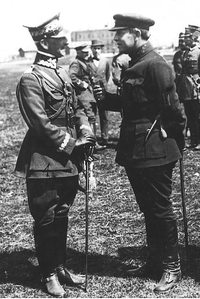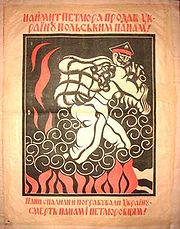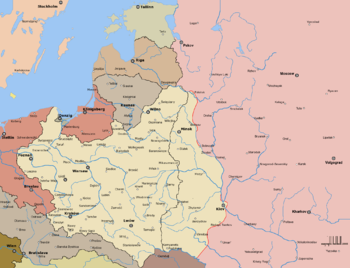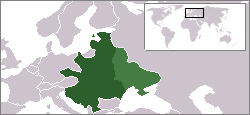
Treaty of Warsaw (1920)
Encyclopedia


Second Polish Republic
The Second Polish Republic, Second Commonwealth of Poland or interwar Poland refers to Poland between the two world wars; a period in Polish history in which Poland was restored as an independent state. Officially known as the Republic of Poland or the Commonwealth of Poland , the Polish state was...
, represented by Józef Piłsudski, and the Ukrainian People's Republic
Ukrainian People's Republic
The Ukrainian People's Republic or Ukrainian National Republic was a republic that was declared in part of the territory of modern Ukraine after the Russian Revolution, eventually headed by Symon Petliura.-Revolutionary Wave:...
, represented by Symon Petlura
Symon Petlura
Symon Vasylyovych Petliura was a publicist, writer, journalist, Ukrainian politician, statesman, and national leader who led Ukraine's struggle for independence following the Russian Revolution of 1917....
, against Bolshevik Russia. The treaty was signed on April 21, 1920, with a military addendum on April 24.
The alliance was signed during the Polish-Soviet War
Polish-Soviet War
The Polish–Soviet War was an armed conflict between Soviet Russia and Soviet Ukraine and the Second Polish Republic and the Ukrainian People's Republic—four states in post–World War I Europe...
, just before the Polish Kiev Offensive. Piłsudski was looking for allies against the Bolsheviks and hoped to create a Międzymorze
Miedzymorze
Międzymorze was a plan, pursued after World War I by Polish leader Józef Piłsudski, for a federation, under Poland's aegis, of Central and Eastern European countries...
alliance; Petlura saw the alliance as the last chance to create independent Ukraine.
The treaty had no permanent impact. The Polish-Soviet War continued and the territories in question were distributed between Russia and Poland in accordance with the 1921 Peace of Riga
Peace of Riga
The Peace of Riga, also known as the Treaty of Riga; was signed in Riga on 18 March 1921, between Poland, Soviet Russia and Soviet Ukraine. The treaty ended the Polish-Soviet War....
. Ukrainian territories were split between the Ukrainian SSR
Ukrainian SSR
The Ukrainian Soviet Socialist Republic or in short, the Ukrainian SSR was a sovereign Soviet Socialist state and one of the fifteen constituent republics of the Soviet Union lasting from its inception in 1922 to the breakup in 1991...
in the east and Poland in the west (Galicia and part of Volhynia
Volhynia
Volhynia, Volynia, or Volyn is a historic region in western Ukraine located between the rivers Prypiat and Southern Bug River, to the north of Galicia and Podolia; the region is named for the former city of Volyn or Velyn, said to have been located on the Southern Bug River, whose name may come...
).
Background
The Polish leader Józef Piłsudski was trying to create a Poland-led alliance of East European countries, the MiędzymorzeMiedzymorze
Międzymorze was a plan, pursued after World War I by Polish leader Józef Piłsudski, for a federation, under Poland's aegis, of Central and Eastern European countries...
federation, designed to strengthen Poland and her neighbors at the expense of Tsarist Russia, and later of the Russian SFSR and the Soviet Union
Soviet Union
The Soviet Union , officially the Union of Soviet Socialist Republics , was a constitutionally socialist state that existed in Eurasia between 1922 and 1991....
. His plan was however plagued with setbacks, as some of his planned allies refused to cooperate with Poland, and others, while more sympathetic, proffered to avoid conflict with the Bolshevik
Bolshevik
The Bolsheviks, originally also Bolshevists , derived from bol'shinstvo, "majority") were a faction of the Marxist Russian Social Democratic Labour Party which split apart from the Menshevik faction at the Second Party Congress in 1903....
s. But in April 1920, from a military standpoint, Polish army needed to strike at the Soviets, to disrupt their plans for an offensive of their own. Piłsudski also wanted an independent Ukraine to be a buffer between Poland and Russia rather than seeing Ukraine again dominated by Russia right at the Polish border. Piłsudski, who argued that "There can be no independent Poland without an independent Ukraine", may have been more interested in Ukraine being split from Russia than he was in Ukrainians' welfare. As such, Piłsudski turned to Petlura, whom he originally had not considered high on his planned allies list.
A Ukrainian delegation could not gain recognition for Ukraine as an independent state at the Treaty of Versailles
Treaty of Versailles
The Treaty of Versailles was one of the peace treaties at the end of World War I. It ended the state of war between Germany and the Allied Powers. It was signed on 28 June 1919, exactly five years after the assassination of Archduke Franz Ferdinand. The other Central Powers on the German side of...
at the end of the First World War, and the Ukrainian dream of independence was also plagued with setbacks, with Ukrainian lands becoming a warzone between various local and foreign factions vying for their control. The Ukrainian People's Republic
Ukrainian People's Republic
The Ukrainian People's Republic or Ukrainian National Republic was a republic that was declared in part of the territory of modern Ukraine after the Russian Revolution, eventually headed by Symon Petliura.-Revolutionary Wave:...
, led by Petlura, suffered mounting attacks on its territory since early 1919, and by April 1920 most of Ukrainian territory was outside its control.
In such conditions, Józef Piłsudski had little difficulty in convincing Petlura to join the alliance with Poland despite recent conflict
Polish-Ukrainian War
The Polish–Ukrainian War of 1918 and 1919 was a conflict between the forces of the Second Polish Republic and West Ukrainian People's Republic for the control over Eastern Galicia after the dissolution of Austria-Hungary.-Background:...
between the two nations that had been settled in favour of Poland the previous year.
The treaty

Warsaw
Warsaw is the capital and largest city of Poland. It is located on the Vistula River, roughly from the Baltic Sea and from the Carpathian Mountains. Its population in 2010 was estimated at 1,716,855 residents with a greater metropolitan area of 2,631,902 residents, making Warsaw the 10th most...
(it should be noted that some sources give the dates 20 and 22 April for the signing of the treaty). In exchange for agreeing to a border along the Zbruch River
Zbruch River
Zbruch River is a river in Western Ukraine, a left tributary of the Dniester.It flows within the Podolia Upland starting from the Avratinian Upland. Zbruch is the namesake of the Zbruch idol, a sculpture of a Slavic deity in the form of a column with a head with four faces, discovered in 1848 by...
, recognizing the recent Polish territorial gains in western Ukraine (Article II) (obtained by the Poland's defeating
Polish-Ukrainian War
The Polish–Ukrainian War of 1918 and 1919 was a conflict between the forces of the Second Polish Republic and West Ukrainian People's Republic for the control over Eastern Galicia after the dissolution of Austria-Hungary.-Background:...
the Ukrainian attempt to create another Ukrainian state in Volhynia
Volhynia
Volhynia, Volynia, or Volyn is a historic region in western Ukraine located between the rivers Prypiat and Southern Bug River, to the north of Galicia and Podolia; the region is named for the former city of Volyn or Velyn, said to have been located on the Southern Bug River, whose name may come...
and Galicia, territories with mixed Ukrainian-Polish population), Poland recognized the Ukrainian People's Republic
Ukrainian People's Republic
The Ukrainian People's Republic or Ukrainian National Republic was a republic that was declared in part of the territory of modern Ukraine after the Russian Revolution, eventually headed by Symon Petliura.-Revolutionary Wave:...
as an independent state (Article I) with borders as defined by Articles II and III and under ataman
Ataman
Ataman was a commander title of the Ukrainian People's Army, Cossack, and haidamak leaders, who were in essence the Cossacks...
Petlura's leadership.
A separate provision in the treaty prohibited both sides from concluding any international agreements against each other (Article IV). Ethnic Poles within the Ukrainian border, and ethnic Ukrainians within the Polish border, were guaranteed the same rights within their states (Article V). Unlike their Russian counterparts, whose lands were to be distributed among the peasants, Polish landlords in Ukraine were accorded special treatment until a future legislation would be passed by Ukraine that would clarify the issue of Polish landed property in Ukraine (Article VI). Further, an economic treaty was drafted, significantly tying Polish and Ukrainian economies; Ukraine was to grant significant concessions to the Poles and the Polish state.
The treaty was followed by a formal military alliance signed by general Volodymyr Sinkler
Volodymyr Sinkler
Volodymyr Oleksandrovych Sinkler or Vladimir Sinclair was a Ukrainian military leader, general of the Russian army, and general of the Ukrainian People's Army....
and Walery Sławek on April 24. Petlura was promised military help in regaining the control of Bolshevik-occupied territories with Kiev
Kiev
Kiev or Kyiv is the capital and the largest city of Ukraine, located in the north central part of the country on the Dnieper River. The population as of the 2001 census was 2,611,300. However, higher numbers have been cited in the press....
, where he would again assume the authority of the Ukrainian People's Republic
Ukrainian People's Republic
The Ukrainian People's Republic or Ukrainian National Republic was a republic that was declared in part of the territory of modern Ukraine after the Russian Revolution, eventually headed by Symon Petliura.-Revolutionary Wave:...
. The Ukrainian republic was to subordinate its military to Polish command and provide the joint armies with supplies on Ukrainian territories; the Poles in exchange promised to provide equipment for the Ukrainians.
On the same day as the military alliance was signed (April 24), Poland and UPR forces began the Kiev Operation, aimed at securing the Ukrainian territory for the Petlura's government thus creating a buffer for Poland that would separate it from Russia. Sixty-five thousand Polish and fifteen thousand Ukrainian soldiers took part in the initial expedition. After winning the battle in the south, the Polish General Staff planned a speedy withdrawal of the 3rd Army and strengthening of the northern front in Belarus
Belarus
Belarus , officially the Republic of Belarus, is a landlocked country in Eastern Europe, bordered clockwise by Russia to the northeast, Ukraine to the south, Poland to the west, and Lithuania and Latvia to the northwest. Its capital is Minsk; other major cities include Brest, Grodno , Gomel ,...
where Piłsudski expected the main battle with the Red Army to take place. The Polish southern flank was to be held by Polish-allied Ukrainian forces under a friendly government in Ukraine.
Importance

Miedzymorze
Międzymorze was a plan, pursued after World War I by Polish leader Józef Piłsudski, for a federation, under Poland's aegis, of Central and Eastern European countries...
federation the legitimacy of joint international effort, secured part of the Polish eastward border, and laid a foundation for a Polish dominated Ukrainian state between Russia and Poland. For Petlura, this was a final chance to preserve the statehood and, at least, the theoretical independence of the Ukrainian heartlands, even while accepting the loss of Western Ukrainian lands to Poland.
Aftermath

Mykhailo Hrushevsky
Mykhailo Serhiyovych Hrushevsky was a Ukrainian academician, politician, historian, and statesman, one of the most important figures of the Ukrainian national revival of the early 20th century...
, the highly respected chairman of the Cetral Rada, also condemned the alliance with Poland and Petlura's claim to have acted on the behalf of the UPR. In general, many Ukrainians viewed a union with Poles with great suspicion, especially in the view of historically difficult relationships between the nations
Polonization
Polonization was the acquisition or imposition of elements of Polish culture, in particular, Polish language, as experienced in some historic periods by non-Polish populations of territories controlled or substantially influenced by Poland...
, and the alliance received an especially dire reception from Galicia Ukrainians who viewed it as their betrayal; their attempted state, the West Ukrainian People's Republic, had been defeated by July 1919 and was now to be incorporated into Poland. The Western Ukrainian political leader, Yevhen Petrushevych
Yevhen Petrushevych
Yevhen Petrushevych was a Ukrainian lawyer, politician, and president of the Western Ukrainian National Republic formed after the collapse of the Austro-Hungarian empire in 1918.-Biography:He was born on June 3, 1863, in the town of Busk, of Galicia in the clerical...
, who expressed fierce opposition to the alliance, left for exile in Vienna. The remainder of the Ukrainian Galician Army
Ukrainian Galician Army
Ukrainian Galician Army , was the Ukrainian military of the West Ukrainian National Republic during and after the Polish-Ukrainian War. -Military equipment:...
, the Western Ukrainian state's defence force, still counted 5,000 able fighters though devastated by a typhoid epidemic, joined the Reds on 2 February, 1920 as the transformed Red Ukrainian Galician Army. Later, the Galician forces would turn against the Reds and join Petliura's forces when sent against them, resulting in mass arrests and disbandment of the Red Galician Army.
On April 26, in his "Call to the People of Ukraine", Piłsudski assured that "the Polish army would only stay as long as necessary until a legal Ukrainian government took control over its own territory". Despite this, many Ukrainians were just as anti-Polish as anti-Bolshevik, and resented the Polish advance, which many viewed as just a new variety of occupation considering previous defeat in the Polish-Ukrainian War
Polish-Ukrainian War
The Polish–Ukrainian War of 1918 and 1919 was a conflict between the forces of the Second Polish Republic and West Ukrainian People's Republic for the control over Eastern Galicia after the dissolution of Austria-Hungary.-Background:...
. Thus, Ukrainians also actively fought the Polish invasion in Ukrainian formations of the Red Army
Red Army
The Workers' and Peasants' Red Army started out as the Soviet Union's revolutionary communist combat groups during the Russian Civil War of 1918-1922. It grew into the national army of the Soviet Union. By the 1930s the Red Army was among the largest armies in history.The "Red Army" name refers to...
. Some scholars stress the effects of Soviet propaganda in encouraging negative Ukrainian sentiment towards the Polish operation and Polish-Ukrainian history in general.
The alliance between Piłsudski and Petliura resulted in 15,000 allied Ukrainian troops supporting Poles at the beginning of the campaign, increasing to 35,000 through recruitment and desertion from the Soviet side during the war. This number, however, was much smaller than expected, and the late alliance with Poland failed to secure Ukraine's independence, as Petlura did not manage to gather any significant forces to help his Polish allies.
On May 7, during the course of the Kiev Offensive, the Pilsudski-Petliura alliance took the city. Anna M. Cienciala
Anna M. Cienciala
Anna M. Cienciala is a Polish-American historian and author. She specializes in modern Polish and Russian history. Graduating with a history doctorate in 1962, she taught at two Canadian universities for a few years before joining the history faculty at the University of Kansas in 1965. She...
writes: "However, the expected Ukrainian uprising against the Soviets did not take place. Ukraine was ravaged by war; also, most of the people were illiterate and had not developed their own national consciousness. Finally, they distrusted the Poles, who had formed a large part of the landowning class in Ukraine up to 1918."
The divisions within the Ukrainian factions themselves, with many opposing Poles just as they opposed the Soviets, further reduced the recruitment to the pro-Polish Petlura forces. In the end, Petlura forces were unable to protect the Polish southern flank and stop the Soviets, as Piłsudski hoped; Poles at that time were falling back before the Soviet counteroffensive and were unable to protect Ukraine from the Soviets by themselves.
The Soviets retook Kiev in June. Petlura's remaining Ukrainian troops were defeated by the Soviets in November 1920, and by that time the Poles and the Soviets had already signed an armistice
Armistice
An armistice is a situation in a war where the warring parties agree to stop fighting. It is not necessarily the end of a war, but may be just a cessation of hostilities while an attempt is made to negotiate a lasting peace...
and were negotiating a peace agreement. After the Polish-Soviet Peace of Riga
Peace of Riga
The Peace of Riga, also known as the Treaty of Riga; was signed in Riga on 18 March 1921, between Poland, Soviet Russia and Soviet Ukraine. The treaty ended the Polish-Soviet War....
next year, Ukrainian territory found itself split between the Ukrainian SSR
Ukrainian SSR
The Ukrainian Soviet Socialist Republic or in short, the Ukrainian SSR was a sovereign Soviet Socialist state and one of the fifteen constituent republics of the Soviet Union lasting from its inception in 1922 to the breakup in 1991...
in the east, and Poland in the west (Galicia and part of Volhynia
Volhynia
Volhynia, Volynia, or Volyn is a historic region in western Ukraine located between the rivers Prypiat and Southern Bug River, to the north of Galicia and Podolia; the region is named for the former city of Volyn or Velyn, said to have been located on the Southern Bug River, whose name may come...
). Piłsudski felt the agreement was a shameless and short-sighted political calculation. Allegedly, having walked out of the room, he told the Ukrainians waiting there for the results of the Riga Conference: "Gentlemen, I deeply apologize to you". Over the coming years, Poland would provide some aid to Petlura's supporters in an attempt to destabilize the Ukrainian SSR
Ukrainian SSR
The Ukrainian Soviet Socialist Republic or in short, the Ukrainian SSR was a sovereign Soviet Socialist state and one of the fifteen constituent republics of the Soviet Union lasting from its inception in 1922 to the breakup in 1991...
(see Prometheism
Prometheism
Prometheism or Prometheanism was a political project initiated by Poland's Józef Piłsudski. Its aim was to weaken the Russian Empire and its successor states, including the Soviet Union, by supporting nationalist independence movements among the major non-Russian peoples that lived within the...
), but it could not change the fact that Polish-Ukrainians relations would continue to steadily worsen over the interwar period. One month before his death Pilsudski told his aide: "My life is lost. I failed to create the free from the Russians Ukraine"
External links
Odezwa Piłsudskiego do Mieszkańców UkrainyFurther reading
- Korzeniewski, Bogusław; THE RAID ON KIEV IN POLISH PRESS PROPAGANDA. Humanistic Review (01/2006), http://www.ceeol.com/aspx/issuedetails.aspx?issueid=40e53184-cef1-4727-8399-631b8bb2cfbd&articleId=218d7e4a-9c96-417f-a7ce-fb3ea7a27928
- Review of The Ukrainian-Polish Defensive Alliance, 1919-1921: An Aspect of the Ukrainian Revolution by Michael Palij; Author(s) of Review: Anna M. Cienciala; The American Historical Review, Vol. 102, No. 2 (Apr., 1997), p. 484 (http://links.jstor.org/sici?sici=0002-8762(199704)102%3A2%3C484%3ATUDA1A%3E2.0.CO%3B2-4)
- Szajdak, Sebastian, Polsko-ukraiński sojusz polityczno-wojskowy w 1920 roku (The Polish-Ukrainian Political-Military Alliance of 1920), Warsaw, Rytm, 2006, ISBN 83-7399-132-8.

